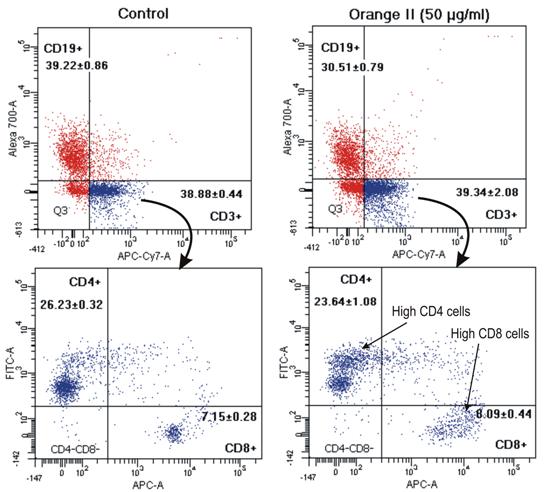13. In vitro studies on immunotoxic potential of Orange II in splenocytes |
Orange II, an azo dye, is not permitted in food preparations, but high levels of the dye have been detected in different food commodities. Though there are reports on the toxicity of Orange II but knowledge based on the immunomodulatory properties of Orange II is scanty. The present investigation was undertaken to study the in vitro immunotoxic potential of Orange II in splenocytes. Splenocytes were iso-lated, cultured and subjected to immunophenotypic analysis, mixed lymphocyte reaction (MLR) assay or stimulated with Lipopolysaccharide (LPS) or Concanavalin A (Con A) for 72 hours. The supernatant was collected for cytokine assays. Orange II showed cytotoxic effects at 100-1000 µg/ml concentrations and 50µg/ml was determined as the highest non-cytotoxic dose. Orange II at the non-cytotoxic dose (50µg/ml) significantly altered the relative distribution of T and B-cells, MLR response and the mitogen induced proliferative response of T-cells and B-cells. Consistent with the hypo-responsiveness of the T and B-lymphocytes, Orange II induced a concomitant decline in the secretion of cytokines IL-2, IL-4, IL-6, IFN-γ, TNF-α and IL-17. On the contrary, there was an increase in the production of IL-10, an anti-inflammatory regulatory cytokine, which may be one of the causative factors for immunosuppressive property of Orange II. These results suggest that non-cytotoxic dose of Orange II may have immunomodu-latory effects.
Yadav et. al; Toxicology Letters; 2012; 208; 239-245.
 Relative distribution of B cells, T cells following exposure of Orange II to splenocytes for 72 hours. T-cells were gated and resolved into CD4+ and CD8+ sub-populations. |